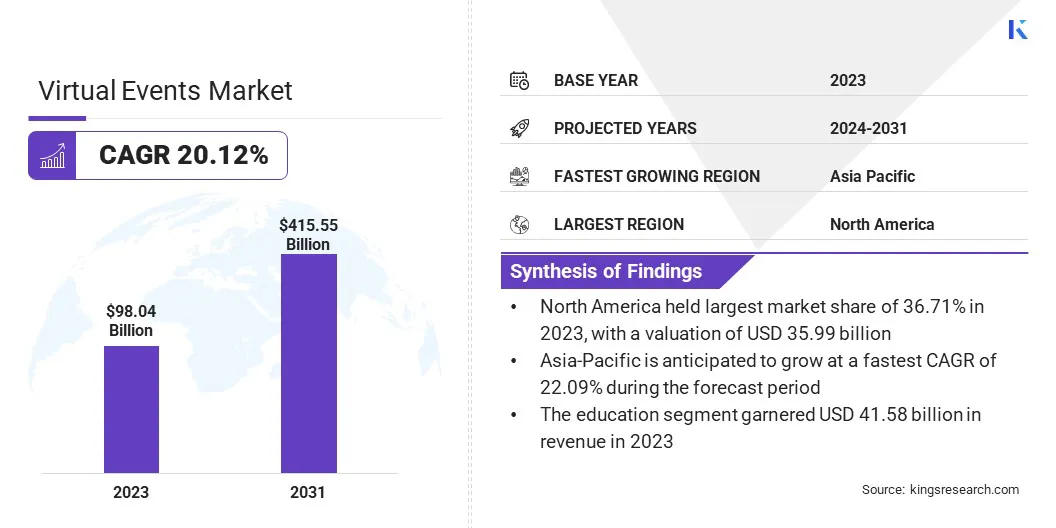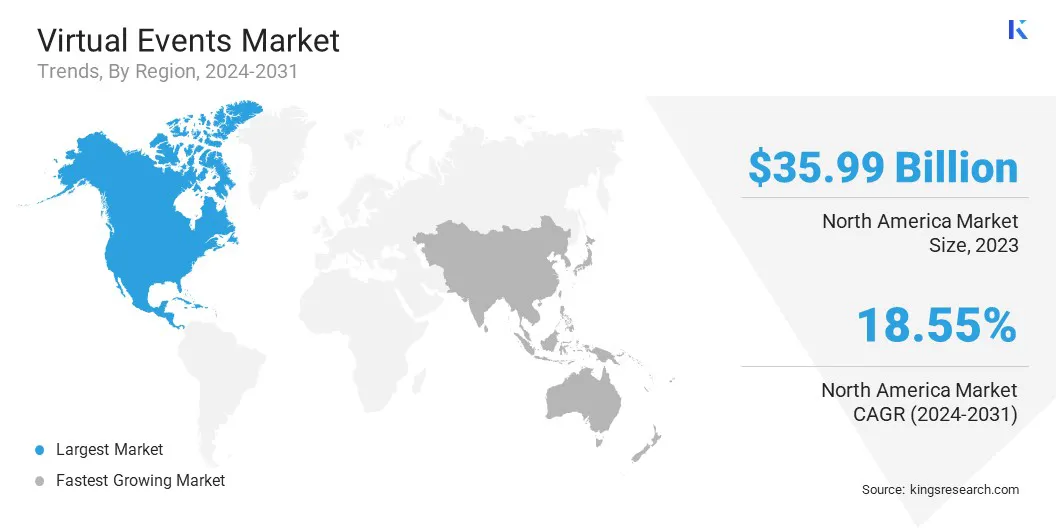Market Definition
Virtual events are online gatherings or conferences conducted through digital platforms, enabling participants to engage, present, and network remotely. Leveraging technologies such as webinars, video conferencing, virtual reality (VR), and live streaming, these events replicate the experience of in-person meetings.
Commonly used for professional conferences, trade shows, product launches, and educational seminars, they offer flexibility and overcome geographical barriers, connecting attendees globally.
Virtual Events Market Overview
Global virtual events market size was valued at USD 98.04 billion in 2023 which is estimated to be valued at USD 115.18 billion in 2024 and reach USD 415.55 billion by 2031, growing at a CAGR of 20.12% from 2024 to 2031.
The market is expanding rapidly due to the rising adoption of digital communication technologies, the surge in remote work, and the demand for flexible event solutions. As businesses prioritize sustainability and remote collaboration, the market is poised to witness sustained expansion, with a strong focus on innovation and user-centric solutions.
Major companies operating in the global virtual events market are American Program Bureau INC., Avaya LLC., ALE International, Cisco Systems, Inc., Cvent Inc., EventX, George P. Johnson., Hubilo, Microsoft Corporation, Remo, RingCentral, Inc., TargetA&M, TCJ Management Co. Ltd., vFairs, Zoom Communications, Inc., and others.
The market is experiencing robust growth, mainly driven by increasing demand for remote and hybrid events. Since the COVID-19 pandemic, companies and organizations have adopted alternative methods to engage with their consumers and audiences, such as hosting remote and hybrid events.
The growing emphasis on digital engagement, coupled with advancements in technology, has fueled the demand for virtual events. Technologies such as augmented reality (AR) and virtual reality (VR) are increasingly integrated into virtual events to deliver immersive experiences, making them a popular choice for concerts, business meetings, and product launches.

Key Highlights:
- The global virtual events market size was recorded at USD 98.04 billion in 2023.
- The market is projected to grow at a CAGR of 20.12% from 2024 to 2031.
- North America held a share of 36.71% in 2023, valued at USD 35.99 billion.
- The webinars segment garnered USD 37.66 billion in revenue in 2023.
- The education segment is expected to reach USD 180.95 billion by 2031.
- Asia Pacific is anticipated to grow at a CAGR of 22.09% during the forecast period.
Market Driver
"Increasing Popularity of Online Streaming"
The increasing popularity of online streaming is fostering the growth of the virtual events market, supported by technological advancements, widespread internet access, and a growing demand for cost-effective and scalable solutions.
Online streaming enables organizations to host webinars, product launches, conferences, and hybrid events with a global reach, overcoming logistical constraints. Real-time engagement tools, such as live chats, polls, and Q&A sessions, enhance audience interaction and data collection.
Furthermore, on-demand access to recorded sessions prolongs event impact, optimizing ROI. As businesses prioritize flexibility and digital-first strategies, online streaming is essential for delivering seamless and immersive virtual experiences.
- For instance, in January 2024, Microsoft launched Microsoft Mesh, an advanced virtual meeting platform integrated with Microsoft Teams. This solution facilitates remote collaboration by enabling employees to interact in a shared virtual environment using personalized avatars. By seamlessly integrating with Teams, Microsoft Mesh enhances the remote work experience, delivering a more immersive and engaging method of connection.
Market Challenge
"Data Privacy and Security Concern"
The virtual events market encounters significant challenges related to data privacy and security concerns. The reliance on digital infrastructure increases the risk of data breaches, unauthorized access, and misuse of sensitive information.
Attendees often share personal and professional details during registration or participation, making robust cybersecurity measures imperative. Failure to ensure adequate protection can result in legal liabilities, reputational damage, and loss of consumer trust.
To mitigate these challenges, companies are investing in advanced encryption, secure access protocols, and regular security audits while ensuring transparency in data handling practices.
Market Trend
"Surging Number of Business Events"
As demand for affordable and scalable solutions increases, companies are increasingly turning to virtual platforms to host conferences, webinars, product launches, and corporate training sessions.
Virtual events provide flexibility and accessibility, enabling businesses to reach global audiences, overcome geographic limitations, and lower costs associated with in-person gatherings. Additionally, technological advancements, including AI-driven networking, interactive features, and real-time analytics, are enhancing the virtual event experience.
As businesses adopt remote solutions, the virtual events market is set to continue to expand, fostering collaboration, enhancing brand visibility, and supporting long-term success.
- According to an article published by Event Cube in 2023, approximately 65% of organizations experienced a rise in event budgets. Virtual events offer participants the flexibility to engage from any location with internet access, enhancing both accessibility and participation rates.
Virtual Events Market Report Snapshot
| Segmentation |
Details |
| By Event Type |
Webinars, Online Conferences, Virtual Trade Shows/Expos, Online Training & Workshops, Others, |
| By End Use |
Education, Healthcare, Government/ Non-profit Organizations, Corporate |
| By Region |
North America: U.S., Canada, Mexico |
| Europe: France, U.K., Spain, Germany, Italy, Russia, Rest of Europe |
| Asia-Pacific: China, Japan, India, Australia, ASEAN, South Korea, Rest of Asia-Pacific |
| Middle East & Africa: Turkey, UAE, Saudi Arabia, South Africa, Rest of Middle East & Africa |
| South America: Brazil, Argentina, Rest of South America |
Market Segmentation:
- By Event Type (Webinars, Online Conferences, Virtual Trade Shows/Expos, Online Training & Workshops, and Others): The webinars segment generated revenue of USD 37.66 billion in 2023, fueled by its ability to facilitate real-time communication between customers and employees, reliminating the need for physical location, and reducing operational costs.
- By End Use (Education, Healthcare, Government/Non-Profit Organizations, and Corporate): The education segment held a share of 42.41% in 2023, as the Covid-19 pandemic accelerated the shift to remote learning, prompting educational institutions to invest heavily in virtual event solutions for hosting lectures, workshops, and conferences.
Virtual Events Market Regional Analysis
North America virtual events market accounted for a significant share of around 36.71% in 2023, valued at USD 35.99 billion. This dominance is propelled by the increasing number of companies and surging adoption of digitally simulated platforms.
Businesses across various sectors are leveraging these platforms to boost efficiency, enhance customer experiences, and maintain a competitive edge in a rapidly evolving digital landscape. This rise is fueled by the growing reliance on digital tools for remote collaboration, training, and process optimization.
Sectors such as healthcare, education, entertainment, and manufacturing are increasingly integrating simulations for practical uses, boosting demand for these platforms.
Furthermore, the widespread adoption of advanced technologies such as virtual reality (VR), augmented reality (AR), and artificial intelligence (AI) accekerates the transition to digital environments, promoting innovation and supporting regional economic growth.

- For instance, in January 2024, vFairs LLC hosted a four-day virtual event for the Bionano Symposium 2024, organized by Bionano Genomics, Inc. The event featured approximately 33 global experts who shared insights into the transformative applications of Optical Genome Mapping (OGM) in clinical research.
Asia-Pacific virtual events market is anticipated to experience the fastest growth, recording a staggering CAGR of 22.09% through the forecast period. Countries such as China, India, Japan, and Australia are at the forefront, leveraging advanced technology to host large-scale conferences, webinars, and trade shows.
Key market players are expanding their presence, aiding regional market growth. Rising disposable income and the surging adoption of new technologies are further propelling this growth.
China’s extensive use of virtual reality (VR) and augmented reality (AR) in corporate events has set a benchmark in the region, while India’s growing startup ecosystem is fueling demand for cost-effective virtual networking platforms. Several regional players are launching virtual events platforms to expand their customer base and market share.
- For instance, in September 2023, Dentsu Group launched xambr, a metaverse infrastructure platform designed to support large-scale event promotions. The platform was first utilized at the virtual venue for the "TOKYO GAME SHOW VR 2023."
Regulatory Framework Also Plays a Significant Role in Shaping the Market
- The U.S. Government implement robust security measures to protect participant data and prevent unauthorized access. This consists utilizing secure platforms with end-to-end encryption, maintaining up-to-date software, and providing participants with education on potential security risks.
- The European Union is introducing new Value Added Tax (VAT) regulations affecting the taxation of virtual events, including online conferences, live-streamed lectures, on-demand training, and live sports broadcasts.
- In APAC, regulations such as China's Personal Information Protection Law (PIPL) and India's Data Protection Act (DPA) enhance attendee trust by ensuring data privacy and security.
Competitive Landscape:
The global virtual events market is characterized by a large number of participants, including both established corporations and rising organisations. Market participants are adopting strategies such as mergers and acquisitions, collaborations and partnerships, product launches, and innovations to stay at the forefront of the market.
Key players are utilizing robust technological systems to deliver a smooth video conferencing experience. Furthermore, these companies are offering services such as event registration, networking, and data tools to grow their businesses.
They are providing scalable communication and networking solutions for virtual events. Event organizing companies are partnering with technology-providing companies to enhance their services and widen their reach.
- For instance, in September 2023, Zoom launched "Production Studio" for its Zoom Events and Zoom Sessions offerings. This feature empowers event professionals to effieicntly design and customize virtual event, delivering a polished and engaging experiences.
List of Key Companies in Virtual Events Market:
- American Program Bureau INC.
- Avaya LLC
- ALE International
- Cisco Systems, Inc.
- Cvent Inc.
- EventX
- George P. Johnson.
- Hubilo
- Microsoft Corporation
- Remo
- RingCentral, Inc.
- TargetA&M
- TCJ Management Co. Ltd.
- vFairs
- Zoom Communications, Inc
Recent Developments
- In September 2024, Vosmos Events introduced a comprehensive suite of AI-driven solutions to revolutionize virtual events by optimizing planning, management, and audience engagement. The platform includes cutting-edge tools such as VIRSA for intelligent matchmaking, VosmosGPT for effortless event setup, and vClip for automated video editing.
- In September 2024, Zoom Video Communications, Inc. and Mitel formed a partnership to enhance enterprise communication solutions. This collaboration combines Zoom's advanced video conferencing technology with Mitel's robust communication systems, delivering seamless connectivity and elevating user experiences in virtual meetings and events.
- In September 2024, Cvent, a provider of meetings, events, and hospitality technology, acquired Splash, an event marketing technology company. Splash’s platform enables marketers to create scalable, branded, and measurable event programs that drive growth and sales.
- In July 2024, Maritz Holdings, Inc. acquired Convention Data Services (CDS), a leading provider of registration and lead services, from Freeman. This strategic acquisition strengthens Maritz's position in the events industry by broadening its service offerings and expanding its client base, particularly in the trade show and association event markets.


